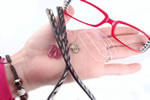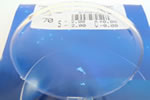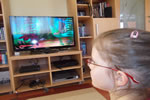Big Lenses with Strong Prescription?
Q: Hey, so I've been looking to get new glasses recently. I really like those big "nerd" or "hipster" styled frames, however with my prescription the optometrist has always said I should get the smallest lenses possible. My prescription is as follows:
R: Sphere 5.75, Cylinder -2.75, Axis 167
L: Sphere 5.00, Cylinder -2.50, Axis 22
Would it be possible for me to get frames with big lenses, or would they always be extremely thick and heavy? Thanks!
A: Well anything is possible, even for bigger diopters like you have.
Because your optometrist said to choose small lenses, I understand that the spherical part of your prescription is minus (-). These lenses are thinner in the middle and thicker on the edges. So the smaller is the lens, the thinner is the edge.
In this case he (or she) is right, the smaller frames are more elegant and the lenses are thinner.
Here are some solutions for lighter lenses and a larger frame:
1. Choose plastic, polycarbonate or trivex lenses and stay away from glass lenses. The only difference between the first ones and the glass is that the last one is heavier, so for light weight lenses stay away from the glass.
2. Choose high index lenses, which means that higher the index, thinner the edges of the lenses. So you can have a bigger frame, with large lenses, and still not very thick edges. You have to be careful because the higher the index, also the price is higher so when you decide to have 1.6 or 1.67 or 1.7 index, ask for the price also.
3. The frame. You said you like a big one, but you may want to choose one that is full frame, so it can conceal the edges of the lenses. If you decide for a rimless or frameless, no matter how high the index is, you will still be able to see the edges. The full frame, even if bigger, will hide the lens edge inside so it won’t be that visible.
4. You also have a cylinder as I see from your prescription, so the lenses edges will not be the same thickness all around. I mean one part will be thicker than the other so this is one more reason to choose the full frame, to hide that.
5. The interpupillary distance also is important to be exact, so be careful how big the frame will be so the lens can be mounted with the right interpupillary distance. If you have a smaller interpupillary distance (58, 60), the big frames are not a good idea. It is impossible to mount a big lens in a big frame for a small face. The mounting is possible, but your vision will not be perfect.
I would say that there is a solution for every problem; the only question is how much you are willing to pay for these solutions.
Related Information
Glasses lens materials
High index lenses
Frame Size
Hope this helps,
Arpi
Join in and write your own page! It's easy to do. How? Simply click here to return to FAQ.
Was this information useful?
1. Like Perfect-Eyeglasses-Guide.com on Facebook.
2. Share this article with your friends:




